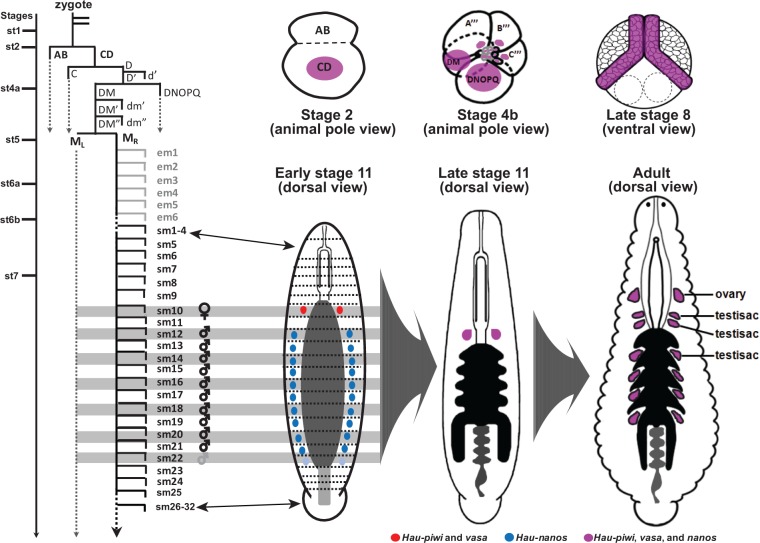Mol Biol Evol. 31(2):341-354, 2014. doi: 10.1093/molbev/mst201
The original version of figure 8 shows the female germ line precursor as arising from the segmental founder cell “sm6,” corresponding to 19 divisions from the zygote; this value also appears at four places in the text. In fact (as stated correctly in the legend to fig. 7), the female germ line arises from segmental founder cell sm10, corresponding to 23 divisions after the zygote. The authors regret the error, and are deeply indebted to Dr. Nicole Rebscher of University of Marburg for calling it to their attention.
Fig. 8.
Diagrammatic summary of germ line marker expression and PGC segregation in Helobdella. Lineage diagram depicting cell divisions leading from the zygote to the segmental founder cells from which female and male PGCs arise, with line drawings showing the expression of conserved germ line markers at selected stages and in the adult leech (nanos, blue; coexpression of piwi and vasa red; coexpression of nanos, piwi and vasa, purple). Time line is approximate: from zygote to stage 7 takes about 54 h at 23 ° C; teloblast cell cycles are 1–2 h. Bilateral M teloblasts arise at seventh cleavage from the division of DM″ (micromere 4d in standard nomenclature for spiralian embryos); each M teloblast undergoes six further rounds of stem cell division that produce nonsegmental early mesoderm blast cells (em1–em6) before producing its first segmental blast cell (sm1, corresponding to segment R1) (Gline et al. 2011); finally, nine further rounds of mitosis occur before the precursors of the female germ line (sm10, segment M6) are separated from the precursors of the male germ line (which arise from the M teloblast starting with sm12, segment M8). As shown in figure 3C, coexpression of all three markers is prominent in teloplasm and teloblast precursors (but is also seen in other cells) during cleavage stages (e.g., stages 2 and 4b), and in the germinal bands and early germinal plate (stage 8). By early stage 11, expression of piwi and vasa has become restricted to the females PGCs (segment M6), whereas nanos is restricted to prospective male PGCs (segments M8–M17 in H. austinensis; and also segment M18 in H. robusta, indicated by paler shading). By late stage 11, expression of all three genes is restricted to the female PGCs. The point at which expression resumes in adult male PGCs remains to be determined. See text for further details. In the adult, ovaries are associated with segment M6 and definitive testisacs with segments M8–M13.
The errors occurred at the following locations in the text.
Page 341, Abstract, the sentence should read:
Here, we have used germ line markers (piwi, vasa, and nanos) and microinjected cell lineage tracers to show that PGC specification in the leech genus Helobdella follows a different scenario: in this hermaphrodite, the male and female PGCs segregate from somatic lineages only after more than 24 rounds of zygotic mitosis; the male and female PGCs share the same (mesodermal) cell lineage for 23 rounds of zygotic mitosis.
Page 342, Introduction, the paragraph should read:
In contrast to our previous characterization of nanos, however, expression of piwi and vasa is first evident in the female germ line. Lineage tracing combined with in situ hybridization (ISH) revealed that as for the male germ line, female PGCs arise from segmental mesoderm. Thus, male and female germline fates separate only after 23 rounds of zygotic mitoses, much later than in several other invertebrate models. Combined with the capacity of some Helobdella species for self-fertilization, our results suggest a mechanism that would contribute to the extensive genomic rearrangements seen in H. robusta and to the rapid speciation of the genus Helobdella relative to other leeches (Oceguera-Figueroa et al. 2011).
Page 347, the reference to figure 8 should read:
Thus, as summarized in figure 8, the male and female germ line fates in Helobdella fates separate from one another only after 23 rounds of zygotic mitoses (and from somatic lineages even later), much later than in other invertebrate models.
Page 350, the reference to figure 8 should read:
Our analysis of germline formation in Helobdella suggests a plausible resolution to this paradox. Whereas Caenorhabditis segregates germline from somatic cells at the fourth zygotic mitosis (and generates male and female gametes by a somewhat indeterminate combination of proliferative and stem cell divisions thereafter; Kimble and Hirsch 1979), ipsilateral male and female PGC lineages in Helobdella are not segregated from each other until 23 rounds of zygotic mitosis have occurred (fig. 8).



